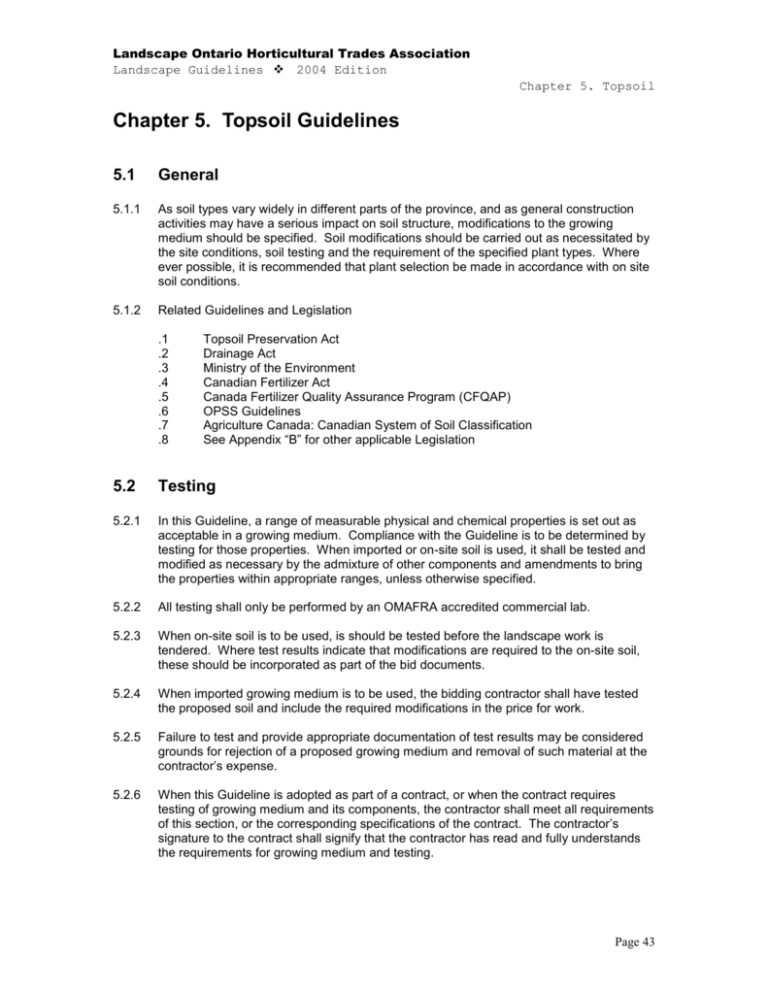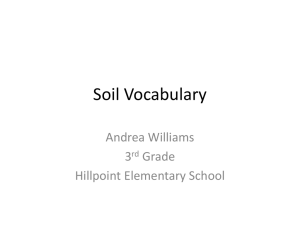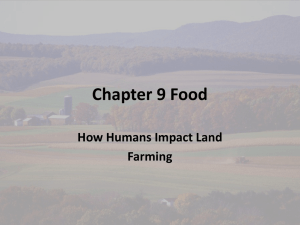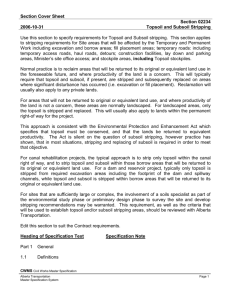Chapter 5. Topsoil Guidelines
advertisement

Landscape Ontario Horticultural Trades Association Landscape Guidelines 2004 Edition Chapter 5. Topsoil Chapter 5. Topsoil Guidelines 5.1 General 5.1.1 As soil types vary widely in different parts of the province, and as general construction activities may have a serious impact on soil structure, modifications to the growing medium should be specified. Soil modifications should be carried out as necessitated by the site conditions, soil testing and the requirement of the specified plant types. Where ever possible, it is recommended that plant selection be made in accordance with on site soil conditions. 5.1.2 Related Guidelines and Legislation .1 .2 .3 .4 .5 .6 .7 .8 Topsoil Preservation Act Drainage Act Ministry of the Environment Canadian Fertilizer Act Canada Fertilizer Quality Assurance Program (CFQAP) OPSS Guidelines Agriculture Canada: Canadian System of Soil Classification See Appendix “B” for other applicable Legislation 5.2 Testing 5.2.1 In this Guideline, a range of measurable physical and chemical properties is set out as acceptable in a growing medium. Compliance with the Guideline is to be determined by testing for those properties. When imported or on-site soil is used, it shall be tested and modified as necessary by the admixture of other components and amendments to bring the properties within appropriate ranges, unless otherwise specified. 5.2.2 All testing shall only be performed by an OMAFRA accredited commercial lab. 5.2.3 When on-site soil is to be used, is should be tested before the landscape work is tendered. Where test results indicate that modifications are required to the on-site soil, these should be incorporated as part of the bid documents. 5.2.4 When imported growing medium is to be used, the bidding contractor shall have tested the proposed soil and include the required modifications in the price for work. 5.2.5 Failure to test and provide appropriate documentation of test results may be considered grounds for rejection of a proposed growing medium and removal of such material at the contractor’s expense. 5.2.6 When this Guideline is adopted as part of a contract, or when the contract requires testing of growing medium and its components, the contractor shall meet all requirements of this section, or the corresponding specifications of the contract. The contractor’s signature to the contract shall signify that the contractor has read and fully understands the requirements for growing medium and testing. Page 43 Landscape Ontario Horticultural Trades Association Landscape Guidelines 2004 Edition Chapter 5. Topsoil 5.2.7 The contractor shall guarantee that the soil submitted for laboratory testing is a representative sample taken (according to the lab recommendations) from the soil that will be delivered to the site. 5.3 Soil Properties 5.3.1 The definition of the appropriate level, according to this Guideline, of soil properties is the responsibility of the design authority. If no specific reference is provided in the contract documents, Table 5-1 should be utilized. (see end of Chapter) 5.3.2 On-Site Topsoil .1 The use of on-site native topsoil is encouraged, provided it meets the guideline for imported growing medium and can be modified to meet the requirements set out or specified for growing medium. Amended subsoil may be considered for use, provided that; additional organic matter is available, the soil structure is acceptable, and a soil test performed on the amended product prior to placement indicates the soil meets guideline growing requirements. .2 Topsoil shall be defined as the existing “A” horizon containing organic matter. Soils lacking in organic matter and consequently not desired for growing medium will generally be recognized by a lighter colouration for the “B” horizon (“B” Horizon or subsoil, less weathered, low in organic matter) and “C” horizons of the soil profile (“C” Horizon or parent material, very little weathering, containing little to no organic matter). .3 All areas of the site designated for hard landscaping, or the construction of structures, shall be stripped of all topsoil and organic matter. Topsoil shall be stripped to its full depth, exercising caution not to mix topsoil with subsoil. .4 Topsoil stripping shall be commenced after the area has been cleared of all scrub, plants, weeds, grass, stumps, rock 75 mm and over, and other extraneous materials. All such resultant materials shall be removed from the site, unless provisions are made on site for the use of such fill. .5 If testing shows it to be a suitable for growing medium, a sufficient quantity of stripped topsoil shall be stockpiled where shown, or in areas designated for stockpiling according to the site drawings, construction planning and scheduling. .6 Topsoil shall not be moved, delivered or worked on while in a frozen, wet or muddy state or condition. .7 Topsoil shall be fertile, friable, sandy loam topsoil. Admixture of subsoil and shall be free of stone over 30 mm in diameter, debris, organic or other deleterious contaminants and fragments larger than 75 mm in size, plants or their roots, sticks, noxious weeds, salts, soil sterilants or other materials detrimental to plant growth. .8 Topsoil shall have acidity range of pH 6 –7.5 and contain not less than 5% OM. .9 Topsoil shall have a salt conductivity of less than 2 millisiemens/cm. Page 44 Landscape Ontario Horticultural Trades Association Landscape Guidelines 2004 Edition Chapter 5. Topsoil 5.3.3 .10 Soil Amendments shall be free from clay subsoil, sawdust, commercial wood products, stones, lumps, plants, roots, sticks, weed stolons and seeds, high seed content, chemical contaminants and other materials harmful to plant life. .11 Topsoil and soil amendments should meet the mechanical analysis as set out in Table 5-2. Imported Growing Medium .1 Imported growing medium shall satisfy the requirements for texture and organic matter given in Table 5-2. Soils shall be virtually free from subsoil, wood including woody plant parts, weed or reproductive parts of weeds, plant pathogenic organisms, vegetation, debris, organic or other deleterious contaminants and fragments larger than 50 mm in size, stones over 30 mm, and foreign objects. Table 5.2 Mechanical Analysis of Topsoil and Amendments Topsoil 1 inch screen 0.5 inch screen # 100 mesh sieve Soil Amendment Mix 2 inch screen 1 inch screen 0.5 inch screen # 100 Mesh Sieve 5.3.4 Passing Percent (%) 100 97-100 40-60 Retained Percent (%) 0 0-3 40-60 100 90-100 50-80 0-15 0 0-10 20-50 85-100 Soilless Media .1 Most container production uses specially prepared growing media called soilless media or potting soils, which are comprised of various organic and inorganic growing medium amendments. .2 An effective soilless media should be: .1 porous and well drained, and able to retain sufficient moisture to meet the water requirements of plants between watering; .2 relatively low in soluble salts, with an adequate caution exchange capacity (CEC) to retain and supply the nutritional elements required for plant growth; .3 Guidelines to permit the use of fertilization and irrigation programs for each successive crop; .4 free from harmful soil pests; pathogenic organisms, chemical pollutants, nematodes and weed seeds; .5 biologically and chemically stable following pasteurization. Page 45 Landscape Ontario Horticultural Trades Association Landscape Guidelines 2004 Edition Chapter 5. Topsoil 5.3.5 5.3.6 5.3.7 Inorganic Components and Amendments .1 Sand: Sand shall be clean, free from impurities, chemical or organic matter. .2 Perlite: Perlite is a siliceous mineral of volcanic origin and is the most commonly used component in soilless growing medium. It is generally included to improve drainage and aeration. Perlite is chemically inert, pH Neutral, weed free, lightweight, sterile and odourless. .3 Vermiculite: Vermiculite is mined as a mineral named hydrated laminar magnesium-aluminum-iron silicate. When heated the mineral exfoliates and expands producing a high water holding capacity and excellent exchange and buffering capacities. Organic Components .1 Sphagnum Peat Moss (Peat Moss) shall be of a horticultural grade. Peat Moss suitable for horticultural purposes should be medium to coarse shredded with a texture varying from porous to spongy fibrous, and substantially homogeneous with a pH value between 3.4 and 5.5. .2 Commercially prepared compost shall be virtually free from all viable weed seeds, or other plant reproductive parts, pathogens, chemicals or toxic contaminates. Physical contaminants such as rock, plastic, metal or glass shall be less than 0.5%. Total carbon to nitrogen ratio in the resulting growing medium shall not exceed 30:1. .3 Mushroom compost or animal manure and compost often provide excessive levels of water-soluble salts. The growing medium shall be leached, before planting with fresh water from irrigation or precipitation until an electrical conductivity of 2.0 mmhos/cm or less is achieved. Fertilizers .1 Fertilizers shall be commercial brands, having a guaranteed N-P-K analysis, meeting the requirements of the Canada Fertilizer Act and the CFQAP. .2 All fertilizers shall be granular, pelletized or pill form, and shall be dry and free flowing, unless particularly specified. .3 Fertilizer shall be packed in waterproof containers, clearly marked with the name of the manufacturer, weight and analysis. .4 All fertilizer shall be stored in a weatherproof storage space and in such a manner that it will be protected from the elements and its effectiveness will not be diminished. .5 The types, formulations, and rates of application for fertilizers shall be as recommended by the laboratory soil specialist, based on the test results of the growing medium, and as approved by the Consultant. Page 46 Landscape Ontario Horticultural Trades Association Landscape Guidelines 2004 Edition Chapter 5. Topsoil 5.3.8 .6 Substitutions or variations in fertilizers and methods shall be made only upon pre-approval by the Consultant. .7 Receipts and empty fertilizer bags should be retained until reviewed by the Consultant as verification that the required fertilizer has been applied. Growing Medium .1 Growing medium is any soil, soil substitute, or mixture whose chemical and physical properties fall within the ranges required by this Guideline for a particular Maintenance Level or as specified in the contract documents. .2 Growing medium shall be virtually free of plants or their roots, sticks, clay, building materials, wood chips, chemical pollutants and other substances at level toxic to plants, and other foreign materials, that detract from the desirable physical and chemical properties for the purpose of landscaping. .3 During the first year; death of plant material that can be attributed to plant pathogenic organisms or toxic materials in the growing medium may indicate that the growing medium did not meet this requirement at the time of installation, and may result in a requirement that the contractor be liable to remove and replace dead plants and replace faulty growing medium. .4 Excessive growth of weeds (as determined by using the maintenance guide in Chapter 16 -Landscape Maintenance, for the level specified) in a growing medium during the first year may be an indication that unacceptable levels of weed seeds or weed parts were present in the growing medium at the time of installation. Such a determination may result in a requirement that the contractor be responsible to reduce the growth of weeds to acceptable levels. .5 Restoration soils my contain roots and wood debris that is considered unacceptable for other uses. A qualified professional consultant should provide test results and amendment recommendations. .6 Soil fertility, pH and organic matter may be modified either during mixing and screening, or after growing medium is placed, by the incorporation of lime and fertilizers. .7 Salinity, the saturation extract conductivity shall not exceed 2.0 millisiemens/cm at 25 C. If it is higher, leaching with fresh water may be required to reduce salinity before planting. See Table 5-3. Page 47 Landscape Ontario Horticultural Trades Association Landscape Guidelines 2004 Edition Chapter 5. Topsoil Table 5-3 Salt Conductivity Levels Conductivity “salt” reading millisiemens/cm 0-0.25 Rating Plant Response Low 0.26-0.45 Medium 0.46-0.70 High 0.71-1.00 Extremely High 1.00 Extremely High Suitable for most plants if recommended amounts of fertilizer used. Suitable for most plants if recommended amounts of fertilizer used. May reduce emergence and cause slight to severe damage to salt sensitive plants. May reduce emergence and cause slight to severe damage to most plants. Expected to cause severe damage to most plants. 5.4 Execution 5.4.1 Growing Medium .1 Commercial processing and thorough mixing of the growing medium components shall be done thoroughly by a mechanized screening process. No hand mixing shall occur. The resulting product shall be a homogeneous mixture having the required properties throughout. Product shall not be stored for excessive periods if a fertilizer component has been mixed. .2 Contamination of components or finished media shall be avoided by keeping amendments in closed bags or by covering outdoor piles. .3 Mixes containing a significant amount of peat moss shall not be permitted to dry out. The moisture content of the peat moss at the time of mixing shall be not less than 60% to 75%. .4 Growing medium shall be moist (25% to 75% of field capacity) but not wet, muddy or frozen when placed. .5 Growing medium in restoration sites must be handled in a way that is appropriate for the application, and should be detailed in the contract documents by a landscape architect or qualified professional. Page 48 Landscape Ontario Horticultural Trades Association Landscape Guidelines 2004 Edition Chapter 5. Topsoil 5.4.2 Placing Growing Medium .1 The sub-grade shall be examined before placing growing medium, and any variation from the requirements of Chapter 4 Grading and Drainage shall be reported and corrected before the placing of the growing medium. .2 Any compacted sub-grade shall be scarified to a minimum depth of 75 to 100 mm immediately before placing growing medium. .3 Growing medium shall be placed and spread over prepared sub-grade and shall be allowed to settle or compacted by light rolling such that it is firm against deep footprints. Growing medium shall not be compacted more than is necessary to meet this requirement. .4 Finished surfaces shall conform to contour lines and elevations on the site or grading plan, by smoothing out variations, bumps, ridges, depressions. .5 Table 5-4 sets out the minimum depths of growing medium after settlement for various types of sub-grade. Table 5-4: Minimum Depths of Growing Medium Application Lawns Ground Cover Areas Small Shrubs Large Shrubs Trees 5.4.3 Over Prepared Subgrade, retaining the "A" horizon 100 mm 150 mm 300 mm 450 mm 600 mm Over rapidly draining soil Over poorly draining soil 150 mm 300 mm 450 mm 600 mm 600 mm 225 mm 225 mm 225 mm 450 mm 600-900 mm Fertilizers .1 Fertilizers shall be added to bring growing media fertility within the ranges set out in this Guideline, as specified or as recommended by the laboratory soil specialist on the basis of testing of the growing medium. .2 Fertilizers shall be uniformly spread over the growing medium with a suitable mechanical spreader. .3 Fertilizers shall be raked into the growing medium to a minimum depth of 50 mm. .4 Fertilizer requirements of restoration sites will depend on the site and the type of plant material used, and shall only be performed in consultation with a qualified professional. Page 49 Landscape Ontario Horticultural Trades Association Landscape Guidelines 2004 Edition Chapter 5. Topsoil Table 5-1: Properties of Growing Medium Texture Coarse Gravel All Gravel Sand Silt Clay Clay and Silt Organic Matter Acidity pH Drainage Canadian System of Soil Classification Diameter (mm) Sand1 to Loamy Sand2 aHigh Level Maintenance Loamy Sand2 to Sandy Loam3 bMedium Level Maintenance 19-40 2-40 0.5-2 0.002-0.5 <0.002 0-1% 0-5% 70-90% 0-30% 0-10% Max 30% 3-5% 6.0-7.0 0-1% 0-5% 43-90% 0-30% 0-20% Max 30% 3-5% 6.0-7.0 0-3% 0-10% 0-52% 0-50% 0-27% Max 48% 5-10% 6.0-7.0 Percolation shall be such that no standing water is visible after 10 minutes of moderate to heavy rain or irrigation Percolation shall be such that no standing water is visible after 10 minutes of moderate to heavy rain or irrigation Grading shall be such that long term surface ponding is eliminated Sandy Loam to Loam4 3 cLow Level Maintenance 1SAND: soil material that contains 85% or more sand; the percentage of silt plus 1.5 X the percentage of clay does not exceed 15. 2LOAMY SAND: soil material that contains the upper limit 85% to 90% sand, and the percentage of silt plus 1.5 X the percentage of clay is not less than 15, at the lower limit it contains not less than 70% to 85% sand, and the percentage of silt plus twice the percentage of clay does not exceed 30. 3SANDY LOAM: soil material that contains either 20% or less clay, with a percentage of silt plus twice the percentage of clay that exceeds 30, and 52% or more sand; or less than 7% clay, less than 50% silt, and between 43% and 52% sand. 4LOAM: soil material that contains 7% to 27% clay, 28% to 50% silt, and less than 52% sand. aLevel High: Irrigation is recommended in all instances and is required in all areas. Plant selection, irrigation requirements and maintenance intensity should consistently respond to the exceptional nature of the growing medium. bLevel Medium: Automatic irrigation is recommended, however such areas can be adequately irrigated through consistent use of manual irrigation equipment. The growing media accommodate a wide selection of plants; create a balance between good drainage and water retention and are suited to moderate, normal maintenance practices. cLevel Low: Irrigation may be provided, but more frequently only temporary watering is done for establishment maintenance. These soils provide a quality growing medium, albeit with reduced percolation and resistance to compaction. These may be imported soils, however existing soils may meet these requirements or it may be possible to amended them to meet the requirements. Plant selections must respond to the limitations of the growing medium and to modest maintenance expectations. If soil must be imported to augment existing site topsoil,the imported growing medium should be similar to the on-site soil and should be thoroughly mixed with it, so as not to create a soil pan. Page 50 Planting Areas and Planters 0-1% 0-5% 50-70% 10-25% 0-20% Max 25% 15-20% 4.5-6.5









